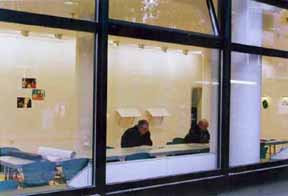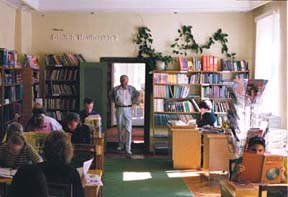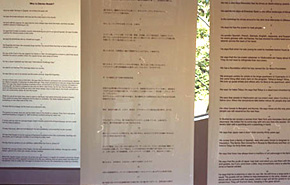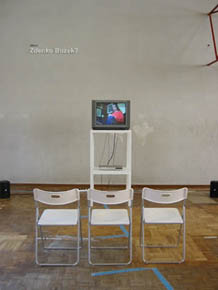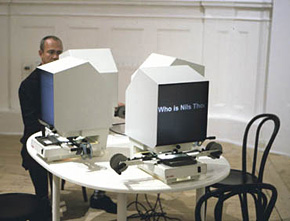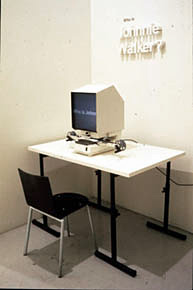After a series of works that used the biographical format and tried to distill stories from the Swedish daily press (where people voice their disappointments and complain about injustices committed against them), I wanted to make a number of portraits that took as their point of departure the banal question, ”Who is…?”—a question that can also be posed as, ”What can one say about a person?” I began to use a kind of mnemonic observation technique whenever I met people for short periods of time, most often on trips. After spending some time with a person, I would write down a kind of statement comprised of short sentences. The resulting texts are a mix of information and narrative (whatever the difference between them may be). The particular stands alongside the general. The idea was to latch on to details and let them later be repeated and accrete.
The people I have become involved with through this project have had the ability to articulate their experiences in a way so that details becomes interesting. In writing these details down, I have not to any greater degree reflected over how representative these fragments are for a ”biography”; rather, the form of the statements in the texts have their own independent logic. It is as if the words were made to be incorporated into a system of information and presentation. The fragments build up a number of themes that are layered and repeated. These texts offer a consistent pattern or a signature theme that anyone can adopt. This aspect can hopefully be emphasized in a web version of ”Who is…?”. After presenting the texts in installation form for several years (on microfilm readers, signs, panels, banners and reading desks I returned to the “characters” asking them to play the role of themselves according to the texts.To recreate and illustrate the fragments, we had to carry out certain actions as well as travel to find specific people. In this way, these bygone words, these events — some more important than others — become yet more concretized. For me, over time the words are transformed into something like artifacts or ”word figures.” Nevertheless, I imagine that despite, or perhaps because of, this simplicity the words will break through people’s preoccupations and lodge themselves in their consciousness in the same way they have in mine. One could say that every encounter with another person contains the potential for giving away the story that each person thinks of as his own — ”my story” — and having it be distorted. In the drive toward sociality and the desire to communicate, there is a standing invitation to take control of each others’ stories. Whoever has spent a lot of time mingling with people will ”be” among these people. This social gain contains an element of ego loss (in the case of my films, the participants are threatened with a double ego loss, since they both mime themselves and give away their ”life stories”). None of this would be possible to carry out without one of the following: 1) a feeling of mutual understanding; 2) a belief that the loss is not threatening; 3) a desire to be seen; 4) a carefree attitude; 5) friendship. There is an estrangement that is valuable and can be differentiated from hate, revulsion, and suspicion toward the stranger. It is valuable insofar as it clarifies differences and lack of understanding. One could speak of a social refraction that liberates ideas, aesthetics, systems of thought, and habits. The characteristics of this initial estrangement (which establish a zone of attentiveness) are diluted with increasing familiarity, and subsequently disappear. In the estrangement lies a vague sense of representation – which can be expressed as a diffuse sense of ethnicity. Even if ”ethnicity” lacks a single, fixed definition, there is no other word that so effectively binds people to their origins, their cultural spheres, and their countries. The person, not yet fully introduced into a friendship, in part represents a larger community — a nation, a language, and possibly a religion. (The person can of course even vaguely represent non-ethnic characteristics such as a shared passion or interest, appearance, illness, profession, and ideology.) Here is a one-dimensionality, which is at its most interesting when it is just in the process of being erased. The narrative voice in the Who is…? films belongs to a young girl who still has relatively little experience of life: she lacks experience. She spells her way through certain sentences with some measure of doubt; others she gives voice to in her own way, sometimes based on a sudden, inspired involvement with some passage in the text. The more important thing here is transformation and letting yourself be taken over. These biographies have all been occupied by someone else. The films have been carried forward by my story. But the voice has an unfamiliar ring to it, even for me.
|

